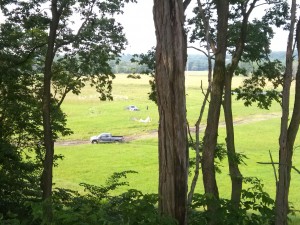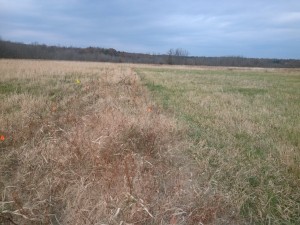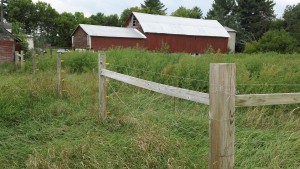Originally posted on September 9, 2015 on the Farming & Climate Change Adaptation Blog
“Flexibility is absolutely the key!” declares Karen Freudenberger, as she looks below where farmers Chuda Mahoro and Theogene Dhaurali are struggling to free one of the farm’s trucks stuck in the mud in a waterlogged pasture. Karen is the Pine Island Community Farm Project Manager, guiding it into existence as a working farm from a conceptual idea formed a few years ago. The majority of the pasture land on this farm is located in the floodplain of the Winooski River, in an oxbow and surrounded on three sides by the river. While extremely fertile, with abundant forage for the 200 or more goats that graze here, the chances of flooded conditions are often present.
While springtime has always been a time of expected flooding, in recent years it has become painfully apparent that flooding can and will happen just about any time of year.
So what does flexibility look like? For the crew at Pine Island, it means the crops and gardens are not necessarily on the best agricultural soil. Flexibility means a grazing plan that includes a “reserve” or “contingency” pasture on the higher ground at the farm that can be utilized at any time to accommodate animals for grazing, should the weather dictate the need to do so.
Pine Island Community Farm represents a partnership between the Vermont Land Trust and the Association of Africans Living in Vermont. It supports New American farmers who wish to raise goats, chickens, or garden crops at the farm and sells pasture grown animals to families who wish to slaughter their own goats and chickens for meat.
It is a collaborative farm where each individual farm enterprise (e.g. Chuda’s goats) is run by the owner as his own small business. Together, the business operations share the land, the barns, and the equipment.
Planning for the Unpredictable
Now in its second year of operation, and finding a rhythm with the land, livestock, and crops – the wild card remains the unpredictable weather fluctuations and learning how to work with that reality. The community gardens were placed on the upper plateau, even though the better agricultural soils are on the river plain below. But the risk of flooding and crop loss is too great on the lower level, and the financial impact could be devastating, so the decision was made to place them up above, requiring substantial amounts of soil amendments to increase the land’s fertility.
The goat enterprise is even more complicated. Since most of them arrive in late winter/early spring as very young animals, it is particularly important that their pasture not be wet or even very damp as those are the conditions most favorable for the internal parasites that can take a young animal down very quickly. Planning for this means reserving a section of the upper plateau for the initial forays onto pasture at the beginning of the grazing season. The chances of this higher elevation land being drier are much better, and lowers the probability the young animals will pick up parasites.
Once the goats have grown in size, become good grazers, learned the process of following a shepherd, and the pasture below has dried up enough – they are taken down each day to fresh forage on the river plain. However, if there is a heavy rain event, the animals are often returned to the barn, and put on hay.
Moving animals prevents parasite intake and is seen as practice for general goat health. Goats traditionally come from dry environments, and have prominent back bones, so when conditions are extremely wet, they can sometimes get a deep chill, particularly young animals. So they are returned to the barn for cover until the weather eases up enough for them to be outside again. The frequency of this procedure has increased in direct correlation with the heavy precipitation events – again an increase in cost due to the extra time and labor involved.
This June and July have proven to be exceptionally wet, and circumstances have pushed the farmers to start utilizing any areas they can find with reasonably dry pasture. Chuda explains how it affects his day and makes for inefficient labor.
“We must spend a long time scouting around for any new dry area, mowing a strip to accommodate fence set-up, putting the fence in place, and bringing the animals there. Normally, long strips would be mowed where several days or even a couple of weeks’ worth of fence line can be set up and a new paddock made each day using the section from the previous day’s paddock as the animals are rotated onto new forage each day”. The labor invested is much less when the paddocks can be made in consecutive blocks, or even close by instead of wandering all over the river plain.
This season has pushed everything to the limits. Because of the record breaking rain and wet conditions, pastures have been slow to dry up and many still have standing water in places, prohibiting their use. Livestock have been restricted to sacrificial paddocks or barnyards and fed any reserved hay from the previous season.
But for many, even the reserve stash is gone. For the same reasons, haying has been delayed and many farmers have not been able harvest any, so without any new crop and reserve supplies depleted, the only choice is to import feed from far away – a costly solution – or eke out any small opportunities close by. This means resorting to a “hunt and pick” type of operation, seeking any bit of dry pasture land that can be found to set up a grazing paddock. The inefficiency brings a greater cost to all – time spent looking and setting each area up takes a good portion of the day, and a watchful eye kept on it all should there be a need to quickly get the animals back to high ground.



Recent Comments